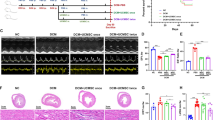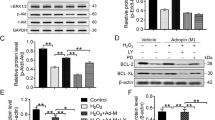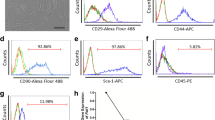Abstract
Small molecules are widely used to induce stem cell differentiation. 2′-deoxycytidine (2-DC) belongs to the cytidine family. It stimulates the expression of cardiac-specific genes and proteins, and directs mesenchymal stem cells towards cardiomyogenic differentiation. We aim to investigate the role of 2-DC-treated human umbilical cord mesenchymal stem cells (UC-MSCs) into myogenic lineage and explore their application in regeneration of infarcted myocardium. UC-MSCs were treated with 5, 10, 20, and 40 µM 2-DC following optimization by cytotoxicity analysis. Rat model of myocardial infarction (MI) was induced by ligating left anterior descending coronary artery. Normal, and 2-DC treated UC-MSCs were transplanted in the left ventricular wall immediately after ligation. Echocardiographic measurements were performed to assess cardiac function. Tissue architecture of the myocardium was examined by histological analysis to determine fate of the transplanted cells. MSCs were successfully isolated from human umbilical cord tissue. 2-DC treatment did not produce any significant cytotoxic effect in UC-MSCs at all concentrations. qPCR analysis of treated UC-MSCs showed induction of myogenic differentiation, which is more pronounced at 20 μM concentration. Fluorescently labeled 2-DC-treated UC-MSCs showed significant (**P < 0.01) homing in the infarcted myocardium as compared to normal UC-MSCs. Hearts transplanted with 2-DC-treated UC-MSCs significantly (***P < 0.001) improved the cardiac systolic and diastolic functions and pumping ability as compared to normal UC-MSCs and MI groups. Fibrotic area and left ventricular wall thickness were significantly improved (***P < 0.001) in 2-DC-treated group as compared to normal UC-MSCs. Immunohistochemical staining showed co-localization of fluorescently labeled cells and patches of differentiated myocytes which were stained for cardiac proteins in the infarct zone implying that the treated UC-MSCs regenerated cardiomyocytes. We report for the first time that 2-DC induces cardiac differentiation in UC-MSCs. Transplanted cells differentiated into functional cardiomyocytes and significantly improved cardiac performance. These pre-differentiated cardiac progenitors showed better survival, homing, and distribution in the infarcted zone. 2-DC treated cells not only improved cardiac function, but also restored tissue homeostasis, suggesting a better therapeutic option for the regeneration of cardiac tissue in the clinical setup.







Similar content being viewed by others
References
McNamara K, Alzubaidi H, Jackson JK (2019) Cardiovascular disease as a leading cause of death: how are pharmacists getting involved? Integr Pharm Res Pract. https://doi.org/10.2147/iprp.s133088
Ohira T, Iso H (2013) Cardiovascular disease epidemiology in Asia: an overview. Circ J 77:1646–1652. https://doi.org/10.1253/circj.CJ-13-0702
Broughton KM, Wang BJ, Firouzi F et al (2018) Mechanisms of cardiac repair and regeneration. Circ Res. https://doi.org/10.1161/CIRCRESAHA.117.312586
Talman V, Ruskoaho H (2016) Cardiac fibrosis in myocardial infarction: from repair and remodeling to regeneration. Cell Tissue Res. https://doi.org/10.1007/s00441-016-2431-9
Liang C, Wang K, Li Q et al (2019) Influence of the distribution of fibrosis within an area of myocardial infarction on wave propagation in ventricular tissue. Sci Rep. https://doi.org/10.1038/s41598-019-50478-5
StJohnSutton MG, Sharpe N (2000) Left ventricular remodeling after myocardial infarction: pathophysiology and therapy. Circulation. https://doi.org/10.1161/01.cir.101.25.2981
Hsich EM (2016) Matching the market for heart transplantation. Circ Hear Fail. https://doi.org/10.1161/CIRCHEARTFAILURE.115.002679
Lazaros G, Oikonomou E, Tousoulis D (2017) Established and novel treatment options in acute myocarditis, with or without heart failure. Expert Rev Cardiovasc Ther. https://doi.org/10.1080/14779072.2017.1262764
Romagnuolo R, Masoudpour H, Porta-Sánchez A et al (2019) Human embryonic stem cell-derived cardiomyocytes regenerate the infarcted pig heart but induce ventricular tachyarrhythmias. Stem Cell Rep. https://doi.org/10.1016/j.stemcr.2019.04.005
Dixit P, Katare R (2015) Challenges in identifying the best source of stem cells for cardiac regeneration therapy. Stem Cell Res Ther. https://doi.org/10.1186/s13287-015-0010-8
Ghafarzadeh M, Namdari M, Eatemadi A (2016) Stem cell therapies for congenital heart disease. Biomed Pharmacother. https://doi.org/10.1016/j.biopha.2016.10.055
Lalu MM, Mazzarello S, Zlepnig J et al (2018) Safety and efficacy of adult stem cell therapy for acute myocardial infarction and ischemic heart failure (safecell heart): a systematic review and meta-analysis. Stem Cells Transl Med. https://doi.org/10.1002/sctm.18-0120
Jeffries MA (2018) Epigenetic editing: How cutting-edge targeted epigenetic modification might provide novel avenues for autoimmune disease therapy. Clin Immunol. https://doi.org/10.1016/j.clim.2018.02.001
Ramos MP, Wijetunga NA, McLellan AS et al (2015) DNA demethylation by 5-aza-2′-deoxycytidine is imprinted, targeted to euchromatin, and has limited transcriptional consequences. Epigenet Chromatin. https://doi.org/10.1186/s13072-015-0004-x
Soler-Botija C, Forcales SV, Bayés Genís A (2019) Spotlight on epigenetic reprogramming in cardiac regeneration. Semin Cell Dev Biol. https://doi.org/10.1016/j.semcdb.2019.04.009
Khan I, Ali A, Akhter MA et al (2016) Preconditioning of mesenchymal stem cells with 2,4-dinitrophenol improves cardiac function in infarcted rats. Life Sci 162:60–69. https://doi.org/10.1016/j.lfs.2016.08.014
Khan I, Ali A, Akhter MA et al (2017) Epac-Rap1-activated mesenchymal stem cells improve cardiac function in rat model of myocardial infarction. Cardiovasc Ther. https://doi.org/10.1111/1755-5922.12248
Beeravolu N, Brougham J, Khan I et al (2018) Human umbilical cord derivatives regenerate intervertebral disc. J Tissue Eng Regen Med 12:e579–e591. https://doi.org/10.1002/term.2330
Dominici M, Le Blanc K, Mueller I et al (2006) Minimal criteria for defining multipotent mesenchymal stromal cells. The International Society for Cellular Therapy position statement. Cytotherapy. https://doi.org/10.1080/14653240600855905
Feng S, Jacobsen SE, Reik W (2010) Epigenetic reprogramming in plant and animal development. Science 330:622–627. https://doi.org/10.1126/science.1190614
Yoon BS, Yoo SJ, Lee JE et al (2006) Enhanced differentiation of human embryonic stem cells into cardiomyocytes by combining hanging drop culture and 5-azacytidine treatment. Differentiation. https://doi.org/10.1111/j.1432-0436.2006.00063.x
Banerjee S, Bacanamwo M (2010) DNA methyltransferase inhibition induces mouse embryonic stem cell differentiation into endothelial cells. Exp Cell Res. https://doi.org/10.1016/j.yexcr.2009.08.011
Choi SC, Yoon J, Shim WJ et al (2004) 5-Azacytidine induces cardiac differentiation of P19 embryonic stem cells. Exp Mol Med. https://doi.org/10.1038/emm.2004.66
Planat-Bénard V, Menard C, André M et al (2004) Spontaneous cardiomyocyte differentiation from adipose tissue stroma cells. Circ Res. https://doi.org/10.1161/01.RES.0000109792.43271.47
Oka T, Maillet M, Watt AJ et al (2006) Cardiac-specific deletion of gata4 reveals its requirement for hypertrophy, compensation, and myocyte viability. Circ Res. https://doi.org/10.1161/01.RES.0000215985.18538.c4
Li H, Zuo S, Pasha Z et al (2011) GATA-4 promotes myocardial transdifferentiation of mesenchymal stromal cells via up-regulating IGFBP-4. Cytotherapy. https://doi.org/10.3109/14653249.2011.597380
Shirinsky VP, Khapchaev AY, Stepanova OV (2008) Molecular mechanisms of cardiomyogenesis and the prospects for cardiomyocyte regeneration in cardiac failure. Mol Biol. https://doi.org/10.1134/S0026893308050130
Somekawa S, Fukuhara S, Nakaoka Y et al (2005) Enhanced functional gap junction neoformation by protein kinase A-dependent and Epac-dependent signals downstream of cAMP in cardiac myocytes. Circ Res. https://doi.org/10.1161/01.RES.0000183880.49270.f9
Khanabdali R, Saadat A, Fazilah M et al (2016) Promoting effect of small molecules in cardiomyogenic and neurogenic differentiation of rat bone marrow-derived mesenchymal stem cells. Drug Des Devel Ther 10:81–91. https://doi.org/10.2147/DDDT.S89658
Gao Q, Guo M, Jiang X et al (2014) A cocktail method for promoting cardiomyocyte differentiation from bone marrow-derived mesenchymal stem cells. Stem Cells Int. https://doi.org/10.1155/2014/162024
Wei JN, Cai F, Wang F et al (2016) Transplantation of CXCR4 Overexpressed Mesenchymal Stem Cells Augments Regeneration in Degenerated Intervertebral Discs. DNA Cell Biol. https://doi.org/10.1089/dna.2015.3118
Song H, Chang W, Song BW, Hwang KC (2012) Specific differentiation of mesenchymal stem cells by small molecules. Am J Stem Cells 1:22–30
Haneef K, Ali A, Khan I et al (2018) Role of interleukin-7 in fusion of rat bone marrow mesenchymal stem cells with cardiomyocytes in vitro and improvement of cardiac function in vivo. Cardiovasc Ther. https://doi.org/10.1111/1755-5922.12479
Caplan AI, Dennis JE (2006) Mesenchymal stem cells as trophic mediators. J Cell Biochem. https://doi.org/10.1002/jcb.20886
Rocha V, Wagner JE, Sobocinski KA et al (2000) Graft-versus-host disease in children who have received a cord blood or bone marrow transplant from an HLA-identical sibling. N Engl J Med. https://doi.org/10.1056/NEJM200006223422501
Hatlapatka T, Moretti P, Lavrentieva A et al (2011) Optimization of culture conditions for the expansion of umbilical cord-derived mesenchymal stem or stromal cell-like cells using xeno-free culture conditions. Tissue Eng Part C Methods. https://doi.org/10.1089/ten.tec.2010.0406
Ennis J, Götherström C, Le Blanc K, Davies JE (2008) In vitro immunologic properties of human umbilical cord perivascular cells. Cytotherapy. https://doi.org/10.1080/14653240801891667
Weiss ML, Anderson C, Medicetty S et al (2008) Immune properties of human umbilical cord Wharton’s Jelly-derived cells. Stem Cells. https://doi.org/10.1634/stemcells.2007-1028
Yoo KH, Jang IK, Lee MW et al (2009) Comparison of immunomodulatory properties of mesenchymal stem cells derived from adult human tissues. Cell Immunol. https://doi.org/10.1016/j.cellimm.2009.06.010
Azari MF, Mathias L, Ozturk E et al (2010) Mesenchymal stem cells for treatment of CNS injury. Curr Neuropharmacol. https://doi.org/10.2174/157015910793358204
Sancricca C (2010) Mesenchymal stromal cells from human perinatal tissues: from biology to cell therapy. World J Stem Cells. https://doi.org/10.4252/wjsc.v2.i4.81
Yang CC, Shih YH, Ko MH et al (2008) Transplantation of human umbilical mesenchymal stem cells from Wharton’s jelly after complete transection of the rat spinal cord. PLoS ONE. https://doi.org/10.1371/journal.pone.0003336
Fu Y-S, Cheng Y-C, Lin M-YA et al (2006) Conversion of human umbilical cord mesenchymal stem cells in Wharton’s Jelly to dopaminergic neurons in vitro: potential therapeutic application for parkinsonism. Stem Cells. https://doi.org/10.1634/stemcells.2005-0053
Xiong N, Zhang Z, Huang J et al (2011) VEGF-expressing human umbilical cord mesenchymal stem cells, an improved therapy strategy for Parkinsons disease. Gene Ther. https://doi.org/10.1038/gt.2010.152
Rasmussen JG, Frøbert O, Holst-Hansen C et al (2014) Comparison of human adipose-derived stem cells and bone marrow-derived stem cells in a myocardial infarction model. Cell Transplant. https://doi.org/10.3727/096368912X659871
Flynn A, Chen X, O’Connell E, O’Brien T (2012) A comparison of the efficacy of transplantation of bone marrow-derived mesenchymal stem cells and unrestricted somatic stem cells on outcome after acute myocardial infarction. Stem Cell Res Ther. https://doi.org/10.1186/scrt127
Gahremanpour A, Vela D, Zheng Y et al (2013) Xenotransplantation of human unrestricted somatic stem cells in a pig model of acute myocardial infarction. Xenotransplantation. https://doi.org/10.1111/xen.12026
Author information
Authors and Affiliations
Corresponding author
Ethics declarations
Conflict of interest
Authors declare that there is no conflict of interest.
Additional information
Publisher's Note
Springer Nature remains neutral with regard to jurisdictional claims in published maps and institutional affiliations.
Rights and permissions
About this article
Cite this article
Ali, S.R., Ahmad, W., Naeem, N. et al. Small molecule 2′-deoxycytidine differentiates human umbilical cord-derived MSCs into cardiac progenitors in vitro and their in vivo xeno-transplantation improves cardiac function. Mol Cell Biochem 470, 99–113 (2020). https://doi.org/10.1007/s11010-020-03750-6
Received:
Accepted:
Published:
Issue Date:
DOI: https://doi.org/10.1007/s11010-020-03750-6




